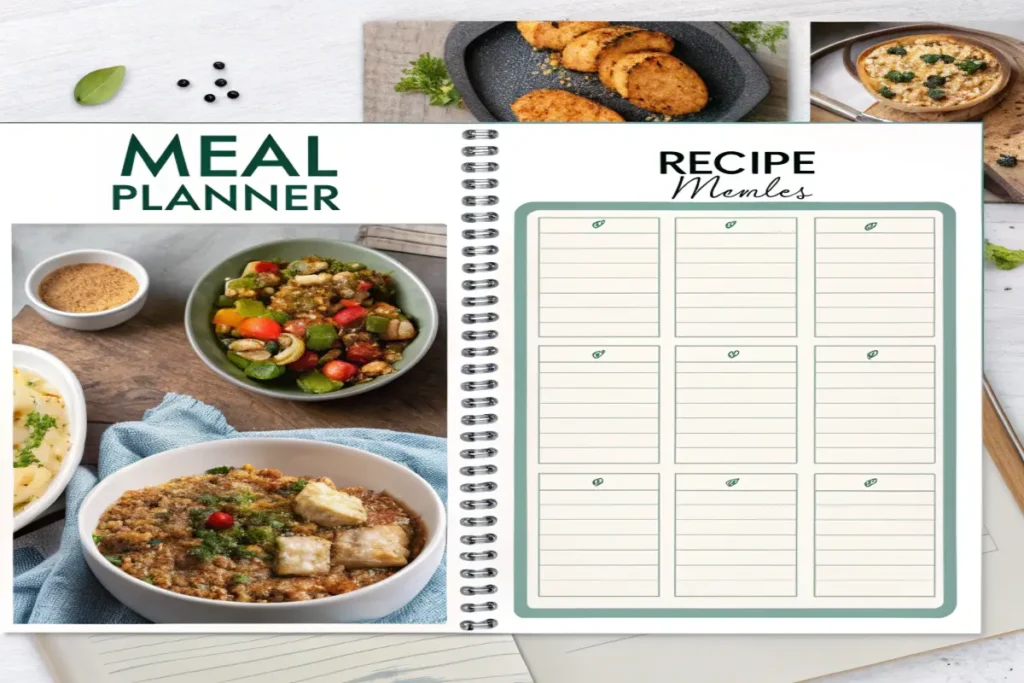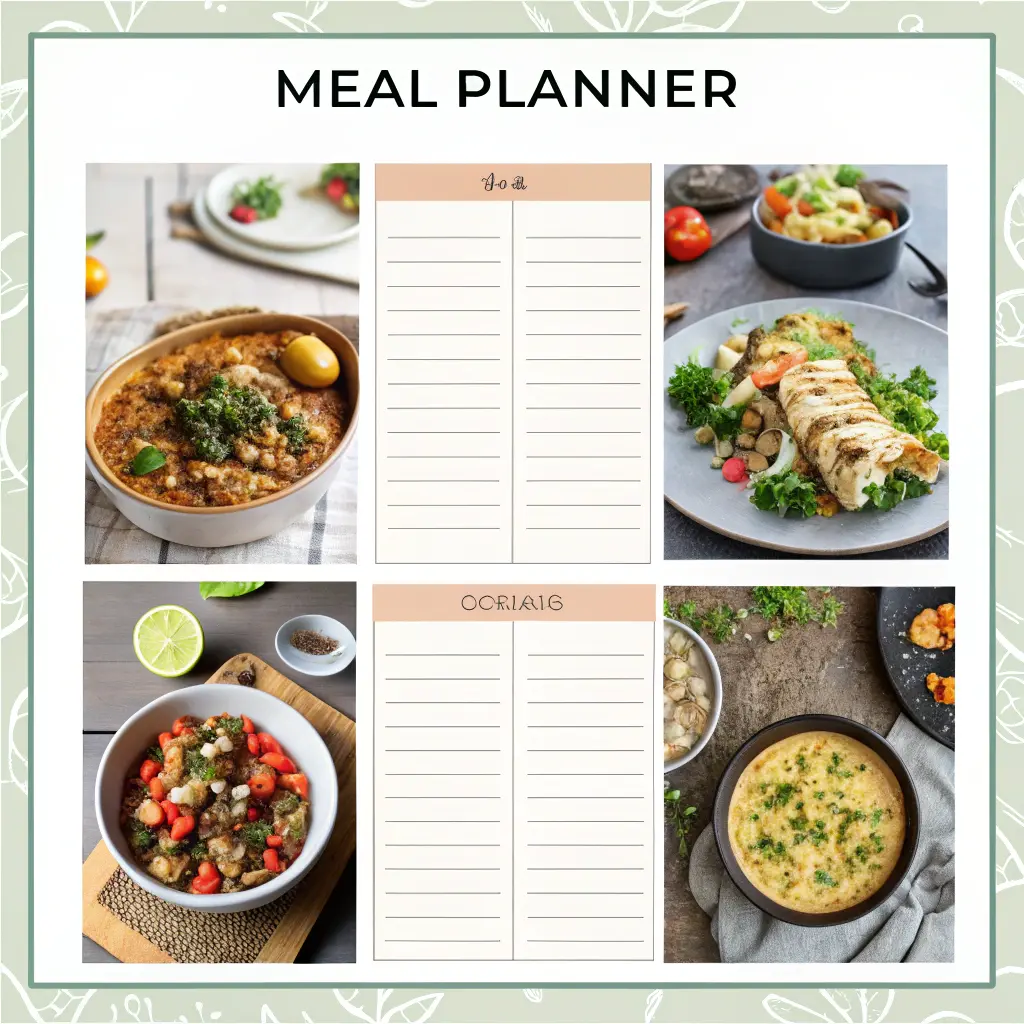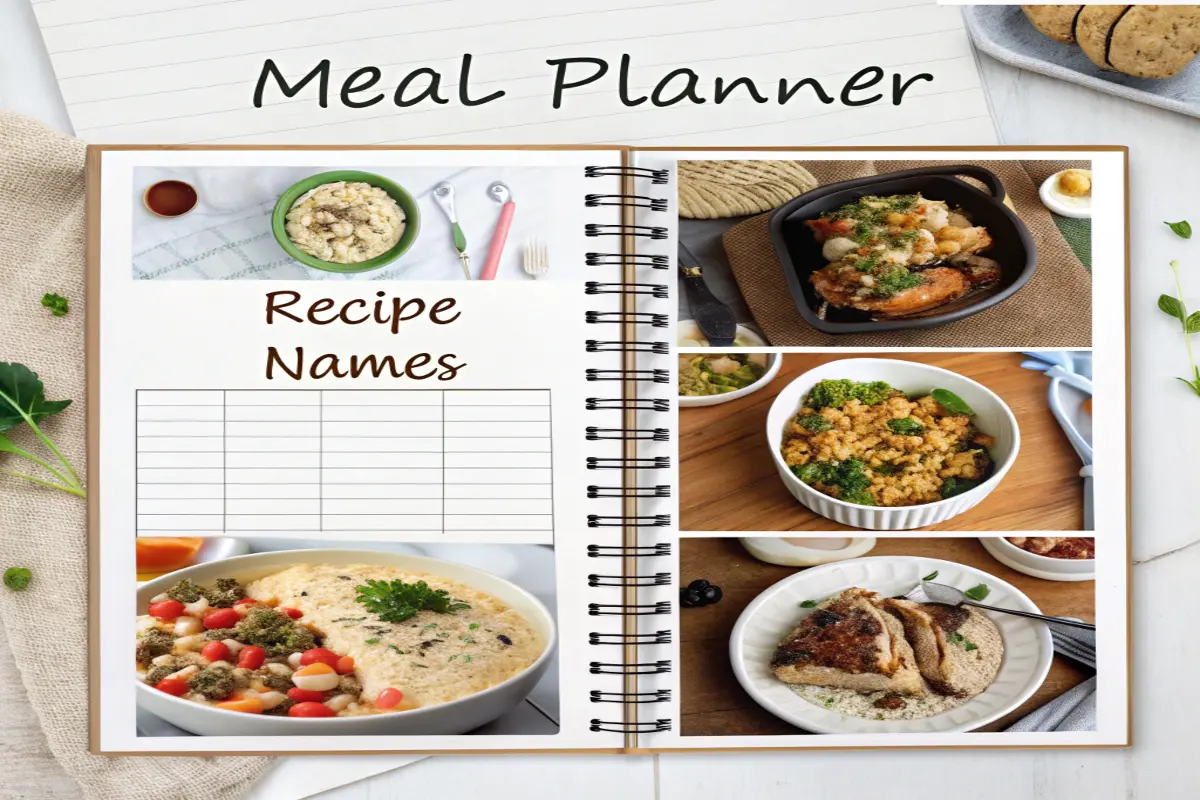What is a Meal Planner and Why Do You Need One?
A meal planner planner is a simple yet powerful tool designed to help individuals organize their meals systematically. Whether it’s a digital app or a handwritten notebook, it offers a structured way to plan what you eat daily, weekly, or monthly.
At its core, a meal planner serves two purposes: convenience and optimization. It eliminates the daily struggle of deciding “What’s for dinner?” while ensuring your meals align with your dietary preferences and lifestyle goals. With a meal planner, you can organize your grocery shopping, reduce food waste, and even save money.
How a Meal Planner Simplifies Your Daily Routine
Imagine waking up every day without the stress of meal decisions. A well-thought-out meal plan provides clarity and structure. Instead of scrambling to prepare a last-minute lunch or dinner, you’ll already know what to cook, what ingredients you need, and how long it’ll take.
A meal planner simplifies your routine in several ways:
- Efficient Grocery Shopping: Create a shopping list based on your weekly plan, avoiding unnecessary purchases.
- Time Management: Meal prepping in advance saves hours during busy weekdays.
- Stress Reduction: With meals planned, you avoid decision fatigue.
By organizing your meals, you’ll find it easier to maintain a balanced diet, stick to your goals, and enjoy a smoother daily flow.
Key Benefits of Meal Planning
1. Time-Saving
Meal planning eliminates the guesswork. Instead of spending 30 minutes figuring out dinner, you’ll already have a plan in place. Meal prepping, such as batch cooking, lets you prepare meals for several days in one go, giving you more time to relax or focus on other tasks.
2. Reduced Food Waste
One of the biggest advantages of using a meal planner is its ability to minimize waste. By planning your meals, you only purchase what you need. This not only reduces food spoilage but also saves money in the long run.
3. Budget Management
When you meal plan, you can allocate your grocery budget wisely. Planning helps you avoid impulse buying, prioritize seasonal ingredients, and take advantage of sales. Over time, you’ll notice significant savings on your food expenses.
How to Make Your Meal Planner Sustainable and Effective
Incorporating Seasonal and Local Ingredients
One way to elevate your meal planner’s sustainability is by incorporating seasonal and local ingredients. Not only do they tend to be fresher, but they’re also more affordable. Shopping seasonally aligns your meals with nature’s bounty, ensuring variety and taste throughout the year.
Local produce often comes with a smaller environmental footprint due to reduced transportation. You can start by exploring your local farmers’ markets or joining a community-supported agriculture (CSA) program. Here are some benefits:
- Fresher produce: Local ingredients are typically harvested at peak ripeness.
- Supporting local farmers: Buying locally supports small businesses and the community.
- Eco-friendly: Seasonal items often require less energy to grow, helping reduce your carbon footprint.
Make it a habit to check what’s in season before finalizing your meal plans. This small change can make a significant difference in the overall sustainability of your meals.
Adapting to Leftovers and Reducing Food Waste
An often-overlooked aspect of a successful meal planner is the ability to adapt and use leftovers creatively. By planning meals that incorporate leftover ingredients, you can significantly reduce food waste. Leftovers can be turned into new meals—think of roasted vegetables transformed into soups or grilled chicken repurposed for salads or wraps.
Here are some quick tips:
- Batch cooking: Make larger portions of meals that freeze well, like soups or casseroles, and store them for future use.
- Leftover transformation: Use leftover grains like rice or quinoa in new dishes, or add leftover meats to stir-fries.
- Smart storage: Label leftovers with dates to ensure they get used within a reasonable timeframe.
By making leftovers part of your plan, you’ll save money and reduce waste, all while maintaining a sustainable meal planning practice.
Tips for Staying Consistent with Meal Planning
Staying consistent with meal planning can be challenging, especially when life gets hectic. However, with a few simple strategies, you can make meal planning a habit:
- Create a routine: Set a fixed day each week to plan your meals. Consider making it a fun event by involving family members.
- Keep it simple: Don’t overcomplicate your meal plans. Start with basic recipes you love and build from there.
- Be flexible: Life happens! If plans change, don’t stress. Adapt your meal plan by swapping out ingredients or meals based on availability.
Consistency comes with practice. The more you use your meal planner, the easier and more efficient it becomes. Over time, meal planning will feel like second nature, giving you more freedom and control over your diet.

Popular Meal Planner Features You Should Look For
Must-Have Features in Digital and Physical Planners
When choosing a meal planner, whether digital or physical, the right features can make all the difference. Here’s what to look for:
- Customizability: A good meal planner should allow you to adjust meal plans based on your preferences.
- Grocery list generator: This feature automatically creates shopping lists based on your weekly plan, saving time and reducing errors.
- Nutritional breakdown: Keep track of your calorie and macronutrient intake if you’re focusing on specific dietary goals.
Whether you’re using a mobile app or a printed planner, a customizable planner gives you the flexibility to make adjustments to your diet and schedule as needed. With built-in shopping lists and meal plan tracking, meal planners become more efficient and tailored to your needs.
Tools for Nutritional Tracking and Recipe Organization
A standout feature of modern meal planners is the integration of nutritional tracking. These tools help you monitor not only the meals you consume but also their nutritional value. This is especially important for those with specific dietary goals, such as weight loss, muscle gain, or managing health conditions like diabetes.
- Nutritional calculators: Many planners come with built-in tools that allow you to calculate the nutritional information of your meals.
- Recipe organization: Store your favorite recipes and easily integrate them into your weekly plans. Some planners allow you to tag recipes based on meal types (breakfast, lunch, dinner) or ingredients.
Having all your recipes and nutritional info in one place streamlines the process and allows you to stay on track with your health goals.
Integration with Grocery Delivery Services
In today’s busy world, the convenience of grocery delivery services is a game-changer. Some digital meal planners offer integration with grocery delivery platforms, allowing you to order your ingredients directly from the app. This seamless integration helps:
- Save time: No need to go grocery shopping; just order everything you need with a few taps.
- Reduce stress: Eliminate the hassle of searching for specific ingredients in-store.
- Stay organized: Everything is neatly laid out in your app, so you don’t forget any items.
If you’re looking to save even more time, look for planners that connect with services like Instacart, Amazon Fresh, or local grocery delivery platforms. This added convenience can help make meal planning feel effortless and more manageable.
Common Challenges in Meal Planning and How to Overcome Them
Lack of Time or Motivation
One of the most common obstacles in meal planning is a lack of time or motivation. It’s easy to put off planning meals, especially when life gets busy, and you feel like you just don’t have the energy to commit to it. However, overcoming this challenge is essential for making meal planning a sustainable habit.
How to Overcome Time Constraints:
- Set a Routine: Dedicate a specific time each week to plan your meals—perhaps Sunday evenings, when you have some downtime.
- Start Small: If planning an entire week feels overwhelming, start with just two or three days of meals. Gradually build your confidence and consistency.
- Meal Prep in Batches: Use your weekends to prep large batches of food that you can store and eat throughout the week. This way, when you’re short on time, you already have healthy meals ready to go.
How to Stay Motivated:
- Make it Fun: Get creative with your meals by trying new recipes or involving family members in meal planning.
- Keep It Simple: Don’t overcomplicate things. Focus on easy, quick recipes that fit your lifestyle and preferences.
- Track Progress: Seeing the positive impact of meal planning—like saving time or sticking to a budget—will motivate you to keep going.
By creating a routine and starting with small, manageable steps, you can easily incorporate meal planning into your busy schedule, transforming it into a habit that works for you.
Dealing with Picky Eaters or Dietary Restrictions
Another common challenge is dealing with picky eaters or accommodating dietary restrictions. Whether you have children who are fussy about food or family members with specific dietary needs, meal planning can become tricky. However, with a little creativity, it’s entirely possible to meet everyone’s preferences without compromising on nutrition.
How to Handle Picky Eaters:
- Involve Them in the Process: Let picky eaters choose some meals or ingredients. When they have a say, they may be more inclined to try new foods.
- Modify Favorite Recipes: For those with strong food preferences, try to adapt their favorite dishes with healthier or more diverse ingredients. For example, add veggies to pasta sauces or try different grains in salads.
- Sneak in Nutrients: If getting certain nutrients into your picky eater’s diet is a struggle, consider sneaking in healthy ingredients in ways that are less noticeable—such as blending spinach into a smoothie or using cauliflower in pizza crust.
Managing Dietary Restrictions:
- Plan for Substitutions: If someone in your household has dietary restrictions—like gluten intolerance or a vegan diet—always plan for substitutions. There are plenty of alternatives available that make meal planning easier.
- Batch Cooking: Consider cooking multiple versions of the same meal to accommodate different dietary needs, like a vegetarian chili and a meat-based chili.
- Research Recipes: Explore recipe blogs, apps, or cookbooks that cater to your specific dietary restrictions, ensuring that everyone enjoys their meals while still meeting their nutritional needs.
Meal planning doesn’t have to be stressful, even with picky eaters or dietary restrictions. By accommodating preferences and making substitutions, you can create a meal plan that satisfies everyone at the table.
Overcoming Budget Constraints
Many people assume that meal planning is an expensive endeavor, especially if you’re buying high-quality ingredients. However, meal planning can actually save money when done strategically. By making conscious choices and adjusting your shopping habits, you can overcome budget constraints and still enjoy healthy, delicious meals.

How to Stick to a Budget:
- Plan Around Sales and Discounts: Check your local grocery store’s weekly flyer or app for sales on staple items like grains, vegetables, and proteins.
- Buy in Bulk: For items you use regularly, such as rice, beans, or pasta, buy in bulk to reduce costs in the long run.
- Cook with Inexpensive Ingredients: Embrace affordable ingredients like beans, lentils, eggs, and seasonal vegetables, which provide a solid nutritional foundation without breaking the bank.
- Limit Processed Foods: Processed foods may seem convenient, but they can quickly add up. Stick to whole ingredients as much as possible to save money and enhance your meals’ nutritional value.
Batch Cooking and Leftovers:
- Freeze Leftovers: If you make too much of a meal, freeze individual portions for future use. This reduces food waste and ensures that you always have a meal ready to go when you’re short on time.
- Make One-Pot Meals: One-pot meals like stews or casseroles are affordable, require fewer ingredients, and usually provide leftovers.
- Repurpose Leftovers: Transform yesterday’s roast chicken into a chicken salad for lunch or use leftover rice in a stir-fry.
By taking a strategic approach to grocery shopping and meal preparation, meal planning can actually save you money. The key is to plan ahead, stick to your budget, and avoid wasteful habits.
With these strategies, you’ll be able to address some of the most common meal planning challenges while ensuring that your plan remains sustainable, cost-effective, and enjoyable for everyone involved.
FAQs: Addressing Your Meal Planner Questions
- What is the best meal planner for beginners?
- A simple, customizable weekly planner is ideal for beginners.
- How can I stick to a meal plan?
- Start small, set realistic goals, and schedule a specific day for meal prep.
- Are there meal planners for specific diets like keto or vegan?
- Yes, several planners cater to specialized diets with pre-set recipes.
- How often should I update my meal planner?
- Weekly updates work well, but you can adjust daily for flexibility.
- Can meal planning save me money?
- Absolutely! It helps you avoid impulse purchases and utilize leftovers efficiently.
- Is digital or paper meal planning better?
- It depends on preference. Digital tools are portable, while paper planners offer a tactile experience.
- What if I don’t follow the plan perfectly?
- It’s okay! Flexibility is key—adjust as needed.
- Do I need to include snacks in my meal planner?
- Yes, planning snacks can help maintain energy levels and avoid overeating.
- Can meal planning help with weight loss?
- Certainly! It supports portion control and balanced eating.
- How do I make meal planning fun?
- Involve your family, experiment with new recipes, or reward yourself for sticking to the plan.
Conclusion: Take Control of Your Diet with a Meal Planner
Meal planning is not just about organizing your meals; it’s about taking charge of your health, budget, and time. With a little effort and creativity, you can transform your daily routine into something stress-free and enjoyable. By investing a bit of time upfront, you can create meals that not only nourish your body but also align with your lifestyle and goals.
The benefits of meal planning are undeniable. It simplifies grocery shopping, ensures healthier food choices, and reduces the chances of impulsive takeout or unhealthy snacks. It’s a tool that empowers you to stay consistent with your diet, avoid food waste, and manage your finances more effectively. Whether you’re cooking for yourself or your family, having a meal plan in place brings order and peace of mind to your kitchen.
Incorporating seasonal ingredients, trying out new recipes, and even embracing leftovers can keep meal planning exciting and fresh. For instance, you could explore creative options like the Avocado Corn Salsa Toast or include something comforting like Chicken and Peppers. For dessert, why not try something fun and visually appealing, such as Heart Cakes or a themed treat like Spiderman Cake Ideas? These ideas keep your meals exciting while catering to diverse tastes and preferences.
As you continue this journey, you’ll find that it’s not just about the meals but also about the time, energy, and money you save.
Start Your Meal Planning Journey Today!
Ready to take control of your diet and lifestyle? Begin your meal-planning journey today! Download a template, explore some handy meal planning apps, or pick up a stylish notebook to get started. Need more inspiration? Browse resources like Low-Calorie Skinny Margarita Recipes for a refreshing twist or explore guides like The Needed Guide to Beef Bacon: Taste, Benefits, and Cooking Tips for more culinary ideas.
Elevate your meal-planning game and make mealtime enjoyable again!

